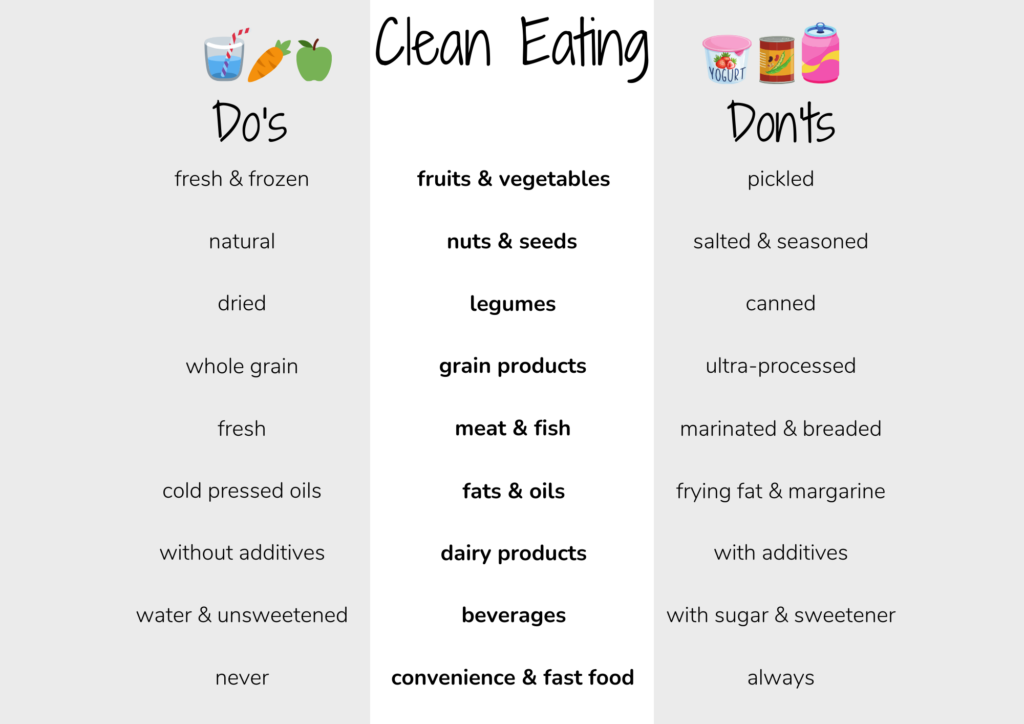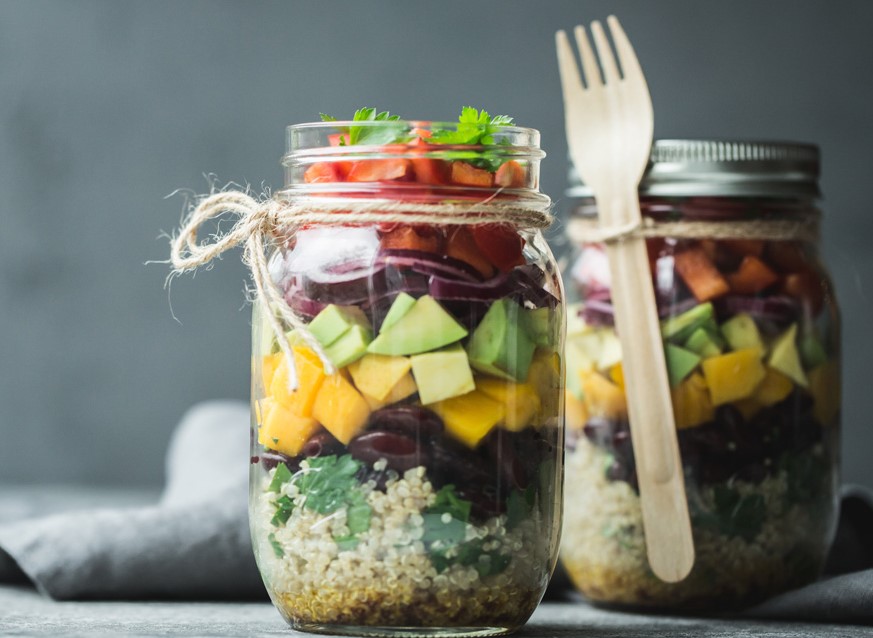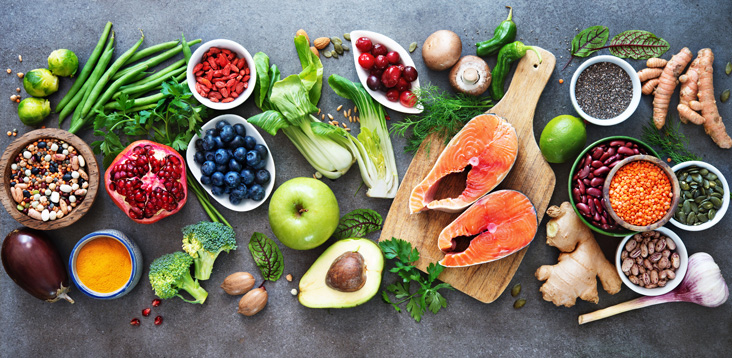
Major points
- Clean Eating focuses on unprocessed foods and strictly avoids ultra-processed foods.
- In Clean Eating, only fresh, natural, and gentlyprepared foods may be consumed. Products are only considered “clean” if they contain a maximum of 5 ingredients.
- Neatic supports the reduction of ultra-processed foods. However, Clean Eating is extremely strict due to its complex rules and strong limitation of food choices, making it difficult to implement it in the long term.
What does Clean Eating stand for?
Clean Eating is a nutritional approach that aims to promote the consumption of fresh, unprocessed foods while avoiding ultra-processed products. Foods should be eaten in their natural state and the consumption of additives and preservatives is minimized.
In Clean Eating, natural and unprocessed foods are the key to better health, based on the motto “You are what you eat”.
What are the benefits of Clean Eating?
Clean Eating can reduce the risk of developing diseases such as type 2 diabetes mellitus or cardiovascular disease, since it avoids ultra-processed foods high in hidden fats and sugars.
Unprocessed foods often have a higher nutrient density, meaning they contain more vitamins, minerals, phytochemicals, and fiber than ultra-processed foods. Therefore, Clean Eating promises more energy throughout the day, no hunger pangs, and improved well-being.
Clean Eating is not a diet but rather a sustainable way of eating. Weight loss is not the main goal. However, depending on the starting weight and previous diet, a few kilos may well be lost.
How does Clean Eating work?
Clean Eating allows only fresh, natural, and gently prepared foods to be consumed.
The general rule is: Products with a maximum of five ingredients are considered “clean.”

Additionally, if you do not know an ingredient found on the ingredient list, the product is not allowed. This means that the ingredient list of packaged foods must be read carefully. However, the application of this rule depends on nutritional knowledge. After all, who knows that complicated-sounding ingredients such as ascorbic acid or E300 actually stand for vitamin C?
The 10 rules of Clean Eating:
1. Stay hydrated with water
Water and unsweetened tea are prioritized as main beverage and 2 to 3 liters per day are recommended. However, 2 to 3 cups of black coffee are also allowed.
2. Eat fruits and vegetables daily
Aim to fill half of your plate with vegetables and fruits at each meal, focusing on a variety of colors for a broad spectrum of nutrients. When shopping, you should pay special attention to regionality and seasonality.
3. Choose whole grains
Choose whole grains which are found in vegetables, legumes, whole grains and pseudo-cereals such as amaranth or quinoa over refined grains like white bread and pasta.
4. Combine carbohydrates with protein
Protein-rich foods such as meat, fish, or dairy products are best combined with whole grains to prevent food cravings.
5. Eat healthy fats
Incorporate sources of healthy fats like avocados, nuts, seeds, olive oil, and fatty fish, while avoiding trans fats and heavily processed oils.
6. Gentle preparation of food
In order to have the highest possible intake of vitamins and minerals, gentle preparation should always be chosen. For example, food should be steamed or stewed rather than seared or grilled.
7. Limit salt intake
Food should be seasoned mainly with fresh or dried herbs and only small amounts of salt.
8. Reduce sugar and avoid sweeteners
Reduce added sugars by avoiding sugary drinks, snacks, and desserts. Choose natural sweeteners like honey or maple syrup in moderation. According to Clean Eating, dried fruits without added sugar, date syrup or apple syrup are suitable for sweetening. Normal household sugar should only be used in small quantities. Sweeteners are additives that should be avoided as a matter of principle.
9. Don’t forget to eat breakfast
A balanced breakfast in the morning is the basis for a good start of your day. A mix of carbohydrates and proteins is recommended, such as oatmeal with yogurt and fresh fruit.
10. Eat several small meals during the day
For long-lasting satiety, it is beneficial to eat several small meals throughout the day. This prevents blood sugar fluctuations and associated cravings.
Clean foods include:
- Fresh or frozen fruits and vegetables
- Dry legumes
- Raw nuts and seeds
- Healthy fats such as olive or pumpkin seed oil
- Milk and dairy products such as natural yogurt or curd
- Unprocessed meat
- Unprocessed fish
- Eggs
- Whole grain products such as rice or pasta
- Healthy sugar alternatives such as date syrup or honey
- Water, unsweetened teas, coffee
Unclean foods include:
- Pickled fruits and vegetables
- Dried fruits with added sugar
- Canned legumes
- Roasted, salted, or seasoned nuts and seeds
- Sweetened dairy products such as fruit yogurt or pudding
- Sweetened milk drinks such as cocoa or milkshakes
- Ready-marinated or breaded meat
- Meat substitutes
- Sausages
- All types of convenience foods
- Ready-made spreads such as jam or hazelnut cream
- Ketchup, barbecue sauces, or salad dressings
- Sweetened beverages

What does science say?
There are no studies that focus on the effects of a Clean Eating diet on body weight and health.
Rather, studies focus on the influence of Clean Eating on eating behavior. The focus on “clean” foods is criticized for leading to disordered eating behavior, where non-clean foods must be avoided at all cost. This, in turn, can contribute to the development of orthorexia: an eating disorder characterized by an obsession with healthy eating.
An Australian study of 762 female participants examined the differences in food intake, food selection, and evaluation of Clean Eating. Participants were divided into three groups according to their prior adherence to Clean Eating recommendations:
- Group 1: never
- Group 2: rarely
- Group 3 frequently
Group 3 participants reported a greater degree of restraint in food intake and had a more positive attitude towards Clean Eating. They were more likely to consume adequate amounts of fruits and meats in contrast to expectations that Clean Eating would limit food choices too strictly.
In another study, Clean Eating and non-Clean Eating recipes were compared in terms of their nutrient profiles and evaluated against the World Health Organization recommendations. Overall, the Clean Eating recipes contained significantly more protein, fat, and fiber per serving than the non-Clean Eating recipes. There were no differences in terms of energy, carbohydrates, sugars, and sodium content. However, less than 10% of the Clean Eating recipes met the World Health Organization constraints for proportions of energy from fat and sugar intake.
What does Neatic recommend concerning Clean Eating?
A positive aspect of Clean Eating is that by limiting ultra-processed foods, the focus is directed towards fresh and natural foods. This reduces the intake of flavors, sweeteners and sugar, as well as the risk of developing diseases such as obesity, type 2 diabetes mellitus, or cardiovascular disease. In addition, it is worth mentioning that the consumption of fruits and vegetables is not limited. Therefore, a craving for sweets can be satisfied by fruit as in Neatic.
In a stressful everyday life, however, Clean Eating is very difficult to implement. It is not always clear whether a food falls under Clean Eating rules, and limiting the number of ingredients makes the choice even more difficult. A meal invitation at a friend’s house or eating out at a restaurant may become challenging. This in turn could lead to more people quitting the Clean Eating concept.
In Neatic, on the other hand, avoiding flavors and sweeteners, as well as reducing sugars, already eliminates more than half of ultra-processed foods. You can find more information about ultra-processed foods and their classification here.
Bibliography:
Allen, Michelle; Dickinson, Kacie M.; Prichard, Ivanka (2018): The Dirt on Clean Eating: A Cross Sectional Analysis of Dietary Intake, Restrained Eating and Opinions about Clean Eating among Women. In: Nutrients 10 (9), S. 1266. DOI: https://doi.org/10.3390/nu10091266.
AOK – Die Gesundheitskasse (2021): Clean Eating: Ernährung ohne Fertigprodukte. Available online at https://www.aok.de/pk/magazin/ernaehrung/ernaehrungsformen/clean-eating-ernaehrung-ohne-fertigprodukte/, last checked 28.03.2023.
Burger, Kathrin (2020): Clean Eating: Ernährungstipps mit Fragezeichen. In: Kathrin Burger (Hg.): Super-Food für Wissenshungrige! Warum wir essen, was wir essen. Berlin, München: Springer; Ciando, S. 117–124.
Dickinson, Kacie M.; Watson, Michelle S.; Prichard, Ivanka (2018): Are Clean Eating Blogs a Source of Healthy Recipes? A Comparative Study of the Nutrient Composition of Foods with and without Clean Eating Claims. In: Nutrients 10 (10), S. 1440. DOI: https://doi.org/10.3390/nu10101440.
